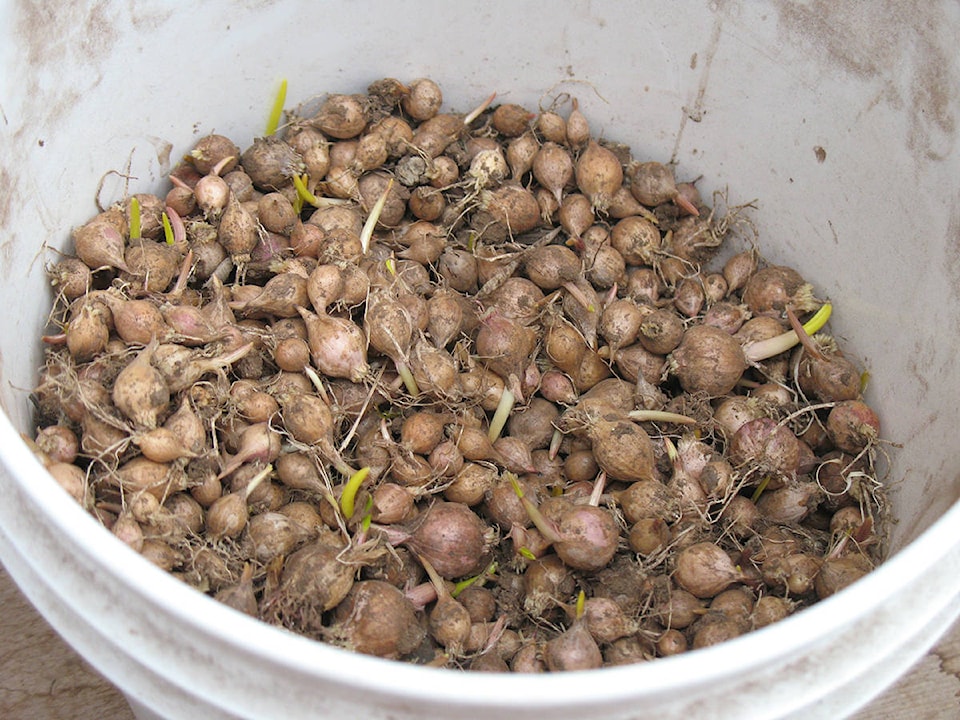By Mary Lowther
Who doesn’t love a garage sale or thrift shop? Rummaging for budget friendly treasures is one of the simple pleasures, and most of us have an item or two we are looking for when we make our husbands pull over for a minute. High on my list are skeins of wool and gardening books I haven’t read yet. This is not a knitting column.
In Growing and Saving Vegetable Seeds author Marc Rogers says “If you raise and save seed you are producing seed for your own garden and, by careful selection over generations you can produce plants best suited to your climate and gardening conditions. Flavour, pest and disease resistance, early bearing and size are among the many characteristics that can be enhanced by judicious selection over the years.”
Three years ago I let some garlic go to seed, allowing the seeds to sprout for two winters. Last July I dug up the half inch bulbs, intending to sow them farther apart. Normally I plant garlic late October, harvest it the following summer and replant the best bulbs in October, but these won’t last that long. Since they’re sprouting in storage I’ll sow them now.
Gardening author Cindy Conner wrote, “Whoever owns the seed controls the food supply.” Henry Kissinger added “Whoever controls the food supply controls the people.” Kissinger’s wasn’t a gardening book, but it made me realize how dependent we are on others.
The sad fact that garlic seed, among many others, can’t be purchased commercially does not mean that we can’t grow our own. Commercial growers say they don’t sell asparagus seed because their customers don’t want to wait the three years it takes to reach fruition. It also allows the suppliers to grow them out and sell the root stock at increased cost. Garlic seems to work the same way and perhaps strawberries too.
I used to buy garlic bulbs, but now that I’ve grown some out long enough to flower and produce bulbils and seeds I may never need to buy garlic again. I’m saving a bundle of money, acclimatizing garlic to my own yard and reducing my dependence on the whims of the market. You have to love a threefer.
Asparagus seed can’t be bought but I’ve grown some. This year I’m going to save seed from potato plants, following the same method as for tomatoes: let some flower and fruit then scoop out the seeds and let them sit in a jar with a bit of water for a few days to ferment, then rinse them off in a sieve. This fermentation kills off any pathogens and cleans off the seeds. Dry the seeds and store in a cold, dry place.
Some day we might be reliant on our own stock of seeds, so it behooves us to learn how to save as many kinds as possible. Commercial growers offer fewer varieties each year, but if we have our own, this won’t matter. Growing vegetables in a small yard or pots need not deter us from saving seeds; it hasn’t stopped me and I’ve found that my own saved seeds actually produce more reliably than those from some suppliers. That garage sale book is absolutely right!
A good place to start is with annual vegetables that go to seed the same year they are sown, like lettuce, peas and beans. Once you’ve got the hang of it, try your hand at biennials like carrots and beets that need to go through a winter in order to set seed the following year. Write the variety of plant on a permanent marker in the garden so it’s easy to keep track of the seed you save. If you swap seeds with someone who’s grown out a different vegetable make sure they followed good isolation practice so you won’t get seeds that have been cross pollinated with something else, like a winter squash that has been cross pollinated with summer squash or a cauliflower crossed with a cabbage.
Please contact mary_lowther@yahoo.ca with questions and suggestions since I need all the help I can get.
